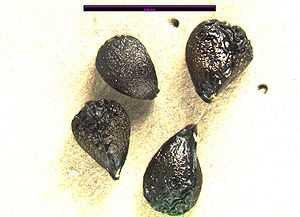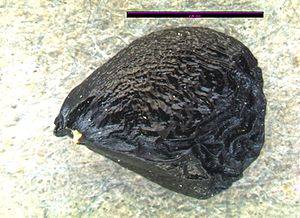Difference between revisions of "Camassia leichtlinii"
(→Bloom Period) |
(→Description) |
||
| Line 18: | Line 18: | ||
==Description== | ==Description== | ||
| − | + | General: Scapose perennial from a deep-seated bulb, the scape 3-5 dm. tall. | |
| − | + | Leaves: Leaves several, all basal, up to 6 dm. long and mostly 7-20 mm. broad. | |
| + | Flowers: Inflorescence a raceme, 1-2 dm. long at flowering, longer in fruit; pedicels 10-40 mm. long, ascending in fruit; flowers light to deep blue-violet; tepals 6, distinct, alike, 2.5-3.5 cm. long and 5-10 mm. broad, twisting above the ovary and covering it; stamens 6, style slender, stigmas 3. | ||
| + | Fruit: Capsule 3-celled, 15-25 mm. long | ||
| + | |||
==Bloom Period== | ==Bloom Period== | ||
April - May | April - May | ||
Revision as of 10:12, 1 May 2012
First overview block: Camassia leichtlinii (Baker) S. Wats. ssp. suksdorfii (Greenm.) Gould Synonyms Liliaceae Large camas, Great camas, Wild Hyacinth
Contents
Taxonomy
- Kingdom Plantae – Plants
- Subkingdom Tracheobionta – Vascular plants
- Superdivision Spermatophyta – Seed plants
- Division Magnoliophyta – Flowering plants
- Class
- Subclass
- Order -
- Family
- Genus
- Species
Description
General: Scapose perennial from a deep-seated bulb, the scape 3-5 dm. tall. Leaves: Leaves several, all basal, up to 6 dm. long and mostly 7-20 mm. broad. Flowers: Inflorescence a raceme, 1-2 dm. long at flowering, longer in fruit; pedicels 10-40 mm. long, ascending in fruit; flowers light to deep blue-violet; tepals 6, distinct, alike, 2.5-3.5 cm. long and 5-10 mm. broad, twisting above the ovary and covering it; stamens 6, style slender, stigmas 3. Fruit: Capsule 3-celled, 15-25 mm. long
Bloom Period
April - May
Habitat
Vernally moist meadows in the lowland zone [1]. Grassy slopes and meadows [2].Nutrients-Nitrogen-rich soils. Moder and Mull humus [3].Moisture Regime-Dry to moderately moist soils [4].Shade Tolerance-Shade-intolerant [5]. Landscaping-Use in meadows, grassy slopes and banks. Showy bloom with attractive seed heads. Very tough plant for exposed, hot dry sites once established [6]. Use in containers or along pond edges [7]
Uses
Use in meadows, grassy slopes and banks. Showy bloom with attractive seed heads. Very tough plant for exposed, hot dry sites once established [8]). Use in containers or along pond edges [9]).
Propagation
Plant bulbs fairly deep and space 6-12” to form a drift in sun in dry to moist but well-drained soil [10]).
Seed
Abbreviation: CALEI
Seed sample from: 2011
Average Measurement: 3.3 x 2.2 x 2.1
Measurement Range: L: 3 - 3.75, W: 2 - 2.5, D: 1.75 - 2.25
Features
Shape: Seed are narrower at hilum end, rounding off at opposite side. Hilum end ranges from tapered to pointy in shape.
Color: Seeds black, with conspicuous white hilum.
Surface: A wrinkled seam runs from hilum down the length of the seed in most. Seed is glossy, and wrinkled or bumpy.
Latitudinal Cross Section: elliptical ![]()
Longitudinal Cross Section: obovate ![]()
Basic Explanations and Assumptions:
The dimensions for the seeds are length x width x depth. The location of the hilum is used as the base of the seed, and the length is measured from hilum to the opposite apex. Where a style is present, the length is measured from the hilum to the bottom of the style. Width is measured at a right angle to the length at the widest part. Depth is measured at a right angle to the intersection of height and width lines.
Measurements included are the mean average for each measurement of ten separate seeds.
All measurements in millimeters unless otherwise noted.



